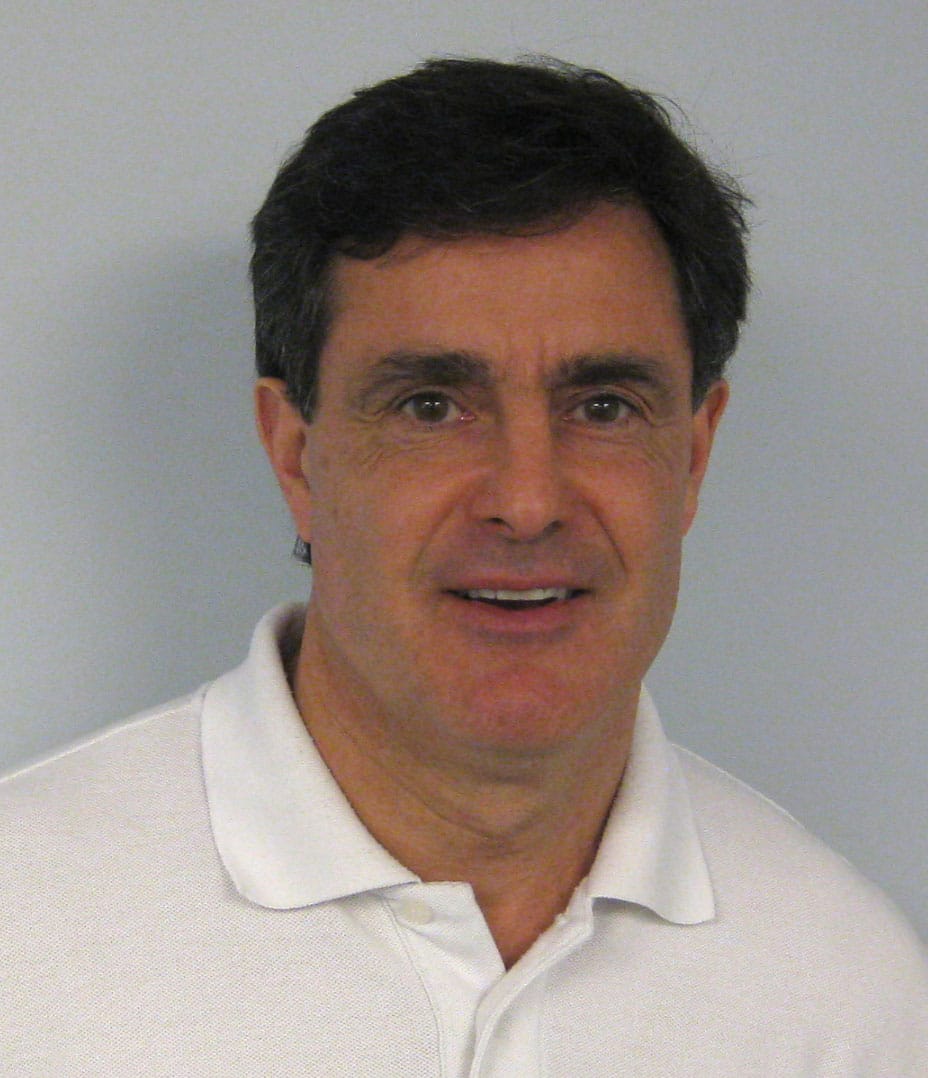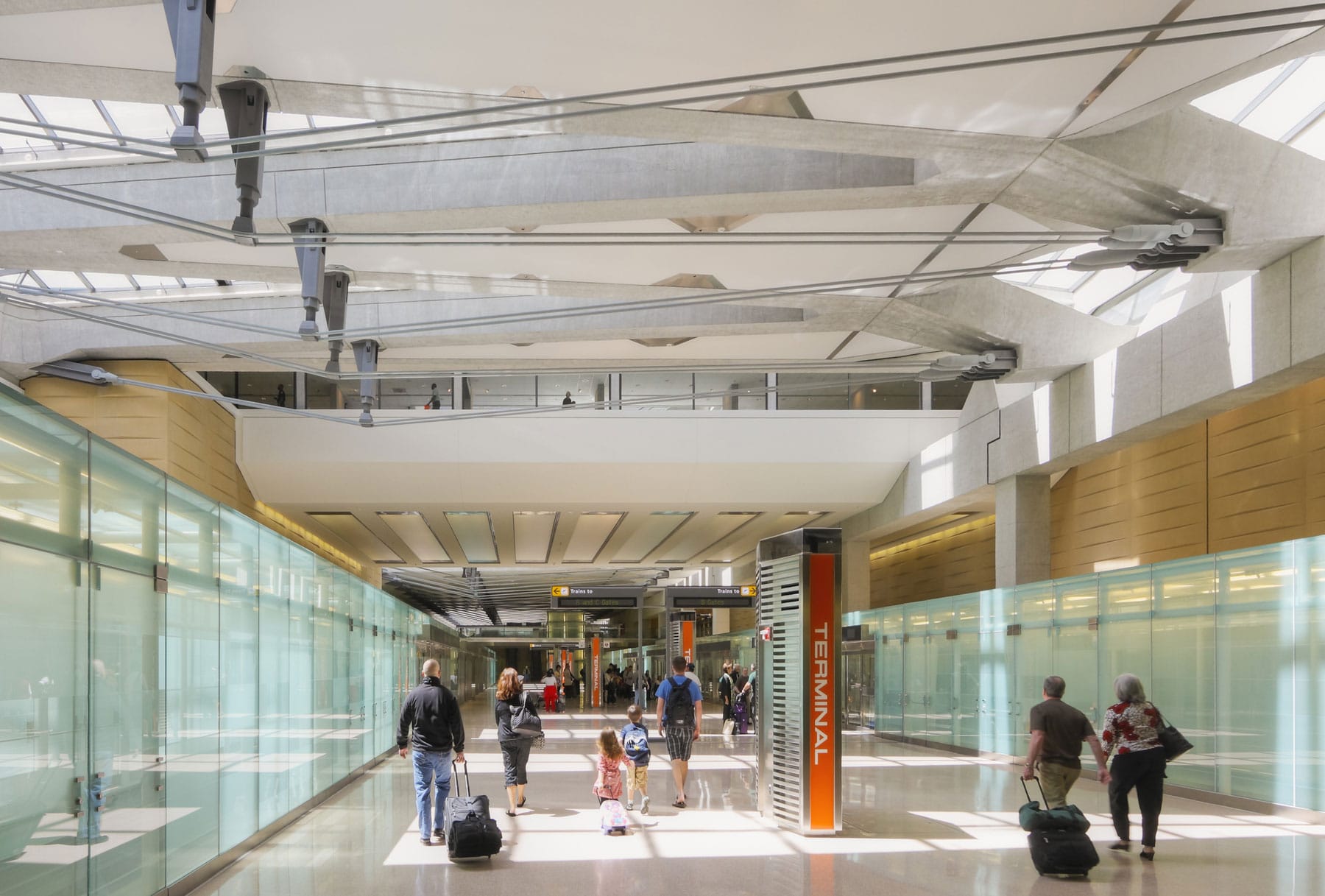
Washington Dulles International Airport
[Courtesy of Newmat]
Newmat Stretch Ceiling Systems reduce noise at airports, museums, and venues across the U.S.
 Download a PDF of this story here.
Download a PDF of this story here.
To learn more about stretch ceiling systems, visit Newmat.
When it comes to sustainable architecture, it’s essential not to consider factors like energy, lighting, and pollution in a vacuum. A building can be considered eco-friendly from a statistical point of view, but it also has to be a pleasure to inhabit and stand the test of time, especially as Americans spend 90% of their time indoors. To that end, Newmat Stretch Ceiling and Wall Systems creates ultra durable, versatile membranes with acoustical and light diffusing properties that can be custom-fitted to walls and ceilings, enhancing visitors’ experience in a wide variety of buildings.
Originally popular in France to encapsulate crumbling plaster from old ceilings, stretch ceilings reached the American market via Pascal Gicquel, now president of Newmat USA. Through the use of a flexible PVC material, available in many finish options and colors, Newmat stretch ceiling systems not only enhance the aesthetics of a room, but can also literally make it more enjoyable by decreasing the cacophony of ambient noises that can be especially overwhelming in places with impenetrable, reflective flooring and ceiling materials. “It has acoustical properties because it’s a tensile material,” explains Tim Greco, president of Newmat Northeast. “When a sound wave hits it, it absorbs it by vibrating instead of reflecting it back.”
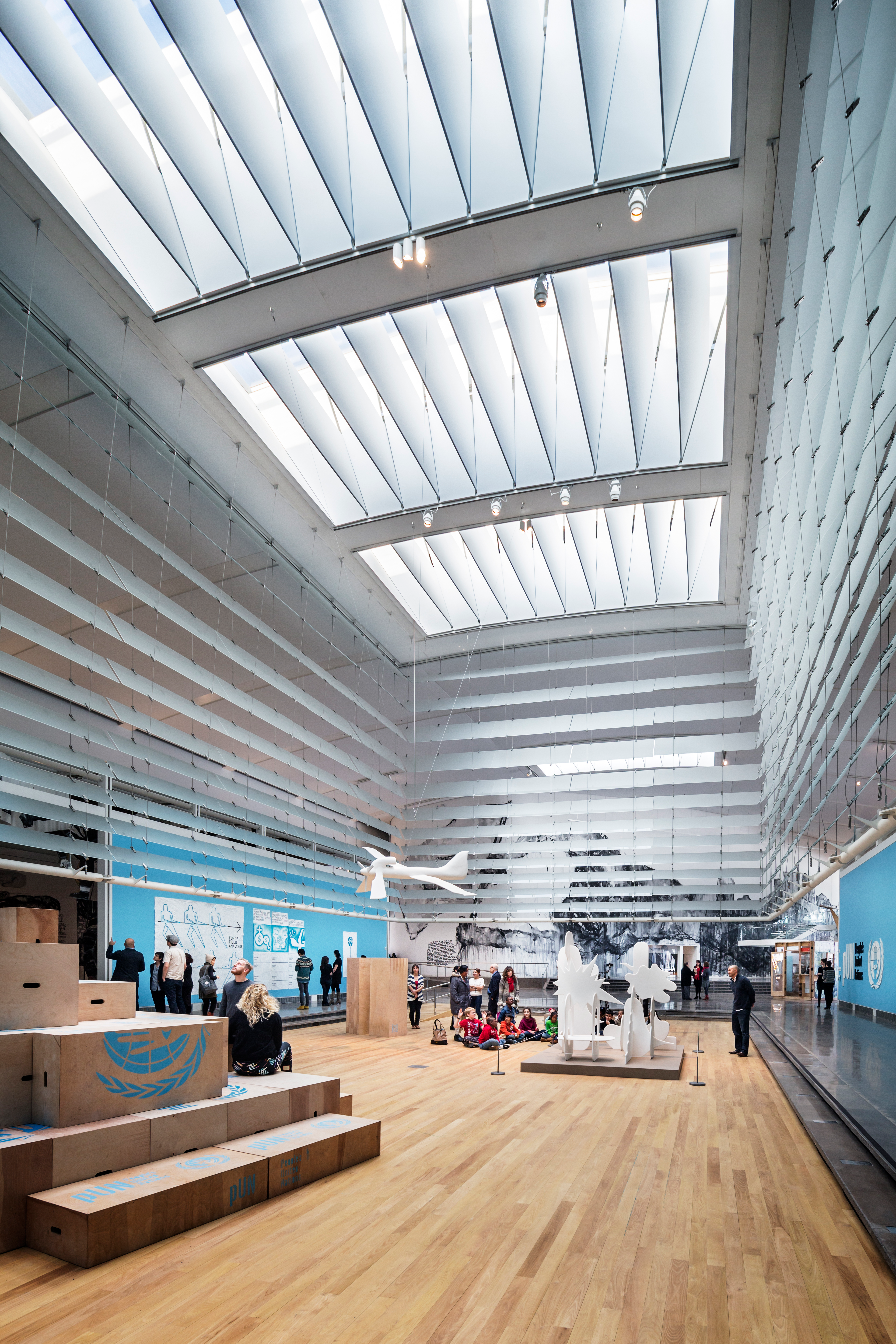
Queens Museum of Art
[Courtesy of Newmat]
Newmat USA has enhanced spaces for airports, museums, churches, and just about any space you can think of. Projects like the Queens Museum of Art (2012–13) required renovation of a 105,000-square-foot interior with perfect lighting and acoustics, resulting in an enormous, light-filled atrium. Newmat installed 55 Newmat Acoustic ceilings, (approximately 27,000 square feet) using ACM15/white matte micro-perforated membranes with custom ghost perimeter rails curved where necessary and acoustical insulation backing. The company also installed 110 custom fabricated ceiling panels/baffles with concealed perimeter angle (approximately 3,000 square feet total) using ACM15/white matte micro-perforated membranes to create the perfect balance between light blocking and light reflecting in skylight areas.
Of course, sound is also important in airports. In 2007–08, Newmat stepped in to offer a solution at Washington Dulles International Airport in the main terminal where passengers come and go in an underground rail and pedestrian system. Considering that it was underground, the space had significant lighting and acoustical issues. Enter the Newmat Light double-layer system, which was installed between the main concrete beams that created the roof structure. The 45,000-square-foot system was backlit with pipe lighting, and both Newmat Light layers were micro-perforated for acoustical absorption.
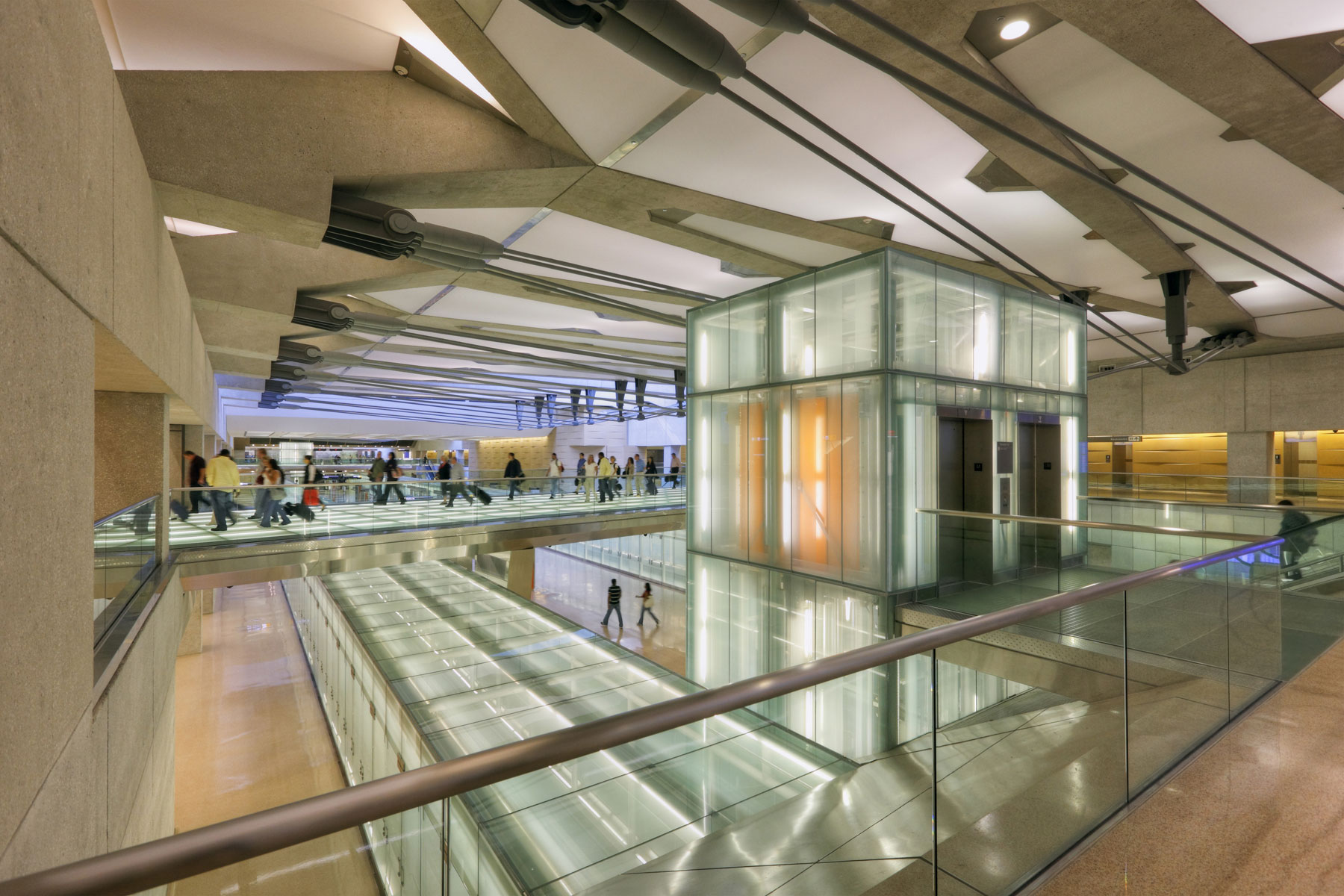
Washington Dulles International Airport
[Courtesy of Newmat]
Newmat most recently worked with the Baltimore Washington International Airport to give its ceiling a makeover and its ambience a major boost. “They chose the product because of its longevity,” Greco says. “They also wanted to address acoustical concerns because it was a new buildout; the space has hard floors and stone floors.” Greco explained that micro-perforating the material is an option to maximize the sound-absorbing qualities of the stretch ceilings, which they chose specifically for the BWI project. “We micro-perforate the material with tiny cone-shaped holes, which allow the sound to travel through and get trapped in the plenum, with or without acoustical backing material,” Greco says. The process is not unlike an acoustical guitar, which uses openings and a perforated material (wood) to achieve the same effect. Depending upon the material selected, an NRC (noise reduction coefficient) of up to 1 is possible. The micro-perforation technology Newmat uses was so innovative in its debut in 1999 that it received both a European and an American patent.
The French-born Pascal Gicquel, president of Newmat USA, came to the U.S. in 1984. He had knowledge of general construction and worked on small-scale residential renovation and addition projects in Long Island. In 1991, he discovered PVC stretch ceiling systems in France and began to develop a market for them in New York. He started Newmat USA in 1999.
Gicquel explains that the non-perforated membranes absorb mainly mid- to low frequencies because of their diaphragmatic action, which converts acoustical energy to heat. When low frequency sound hits a solid acoustic membrane, instead of reflecting off the membrane and contributing to a room’s total sound energy, the energy causes the membrane itself to resonate. Perforated membranes allow more high frequency information through, which is attenuated in the cavity with backing materials. At the same time, more energy is reflected than if the backing material were fully exposed, preventing a space that sounds “dead.” Perforated membranes act as a Helmholtz resonator, which effectively tune the absorption based on the dimensions of the perforations and the cavity depth. Micro-perforations allow for the same benefits as standard perforations while maintaining a uniform and smooth appearance, even at low ceiling heights.
Even More Benefits
Newmat ceilings are resistant to mold, mildew, and condensation, even in moist environments, like the company’s very first U.S. project in the Waldorf Astoria Hotel bathrooms. This is an especially valuable quality in buildings with very high ceilings that make maintenance a challenge.
“Routine access (and emergency access) to things like lights, sprinklers, and smoke detectors is easily accomplished because all of the Newmat systems are fully accessible. In the case of a panelized system, the client always has access; in the case of a stretched wall-to-wall system, a trained and certified Newmat installer provides the access,” Greco says. Newmat installations can sometimes be done “same day.” “Unlike other ceiling systems, Newmat membranes are extremely light (5 pounds per 100 square feet),” Gicquel says. “As an example, a team of four installers can install 1,000 square feet in one day. In addition, once it is stretched [to fit the dimensions of the space], you are done. There is no spackling, painting, or finishing necessary.” While a monolithic fabric is simplest, the product can be trimmed and joined to fit whatever size or shape it needs to match to cover a more irregular or dome-shaped ceiling. Moreover, it can be designed and supported to mimic organic and undulating shapes, to create a truly unique installation, such as in the 2014 Los Angeles Acura Exhibit, where two large intertwined rings were supported with an aluminum skeleton, onto which printed wood veneer membranes and satin metallic finish membranes were stretched.
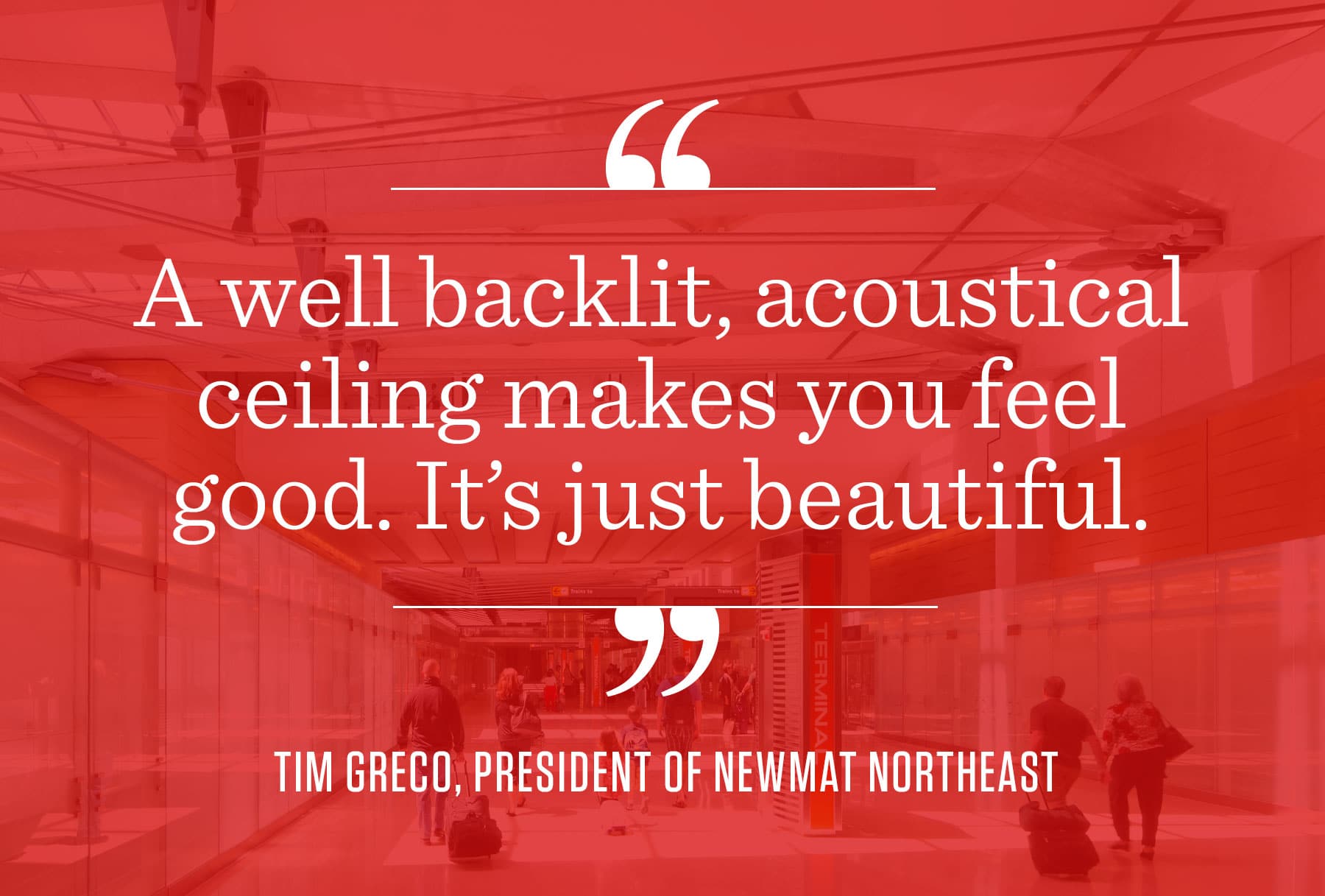
“I’ve seen firsthand the before and after with our ceiling systems,” says Gicquel, referencing a restaurant project he worked on. “Large numbers of patrons were complaining about their inability to understand the person next to them due to poor acoustics.” Gicquel suggested they outfit their existing drywall ceilings with micro-perforated membrane and acoustical backing. “The owner couldn’t thank us enough,” he says. The dining experience could finally match the excellent quality of the food.
Greco’s favorite aspect of Newmat stretch ceilings is when they are implemented in conjunction with light design. “People really underestimate the importance of a nice atmosphere,” he says. “It makes a huge difference in how you feel when you’re in it.” A large, monolithic ceiling system can overlay backlighting to create a soft and ambient glow that really affects the mood, pace, and tone of a space. “A well backlit, acoustical ceiling makes you feel good. It’s just beautiful,” he says.

